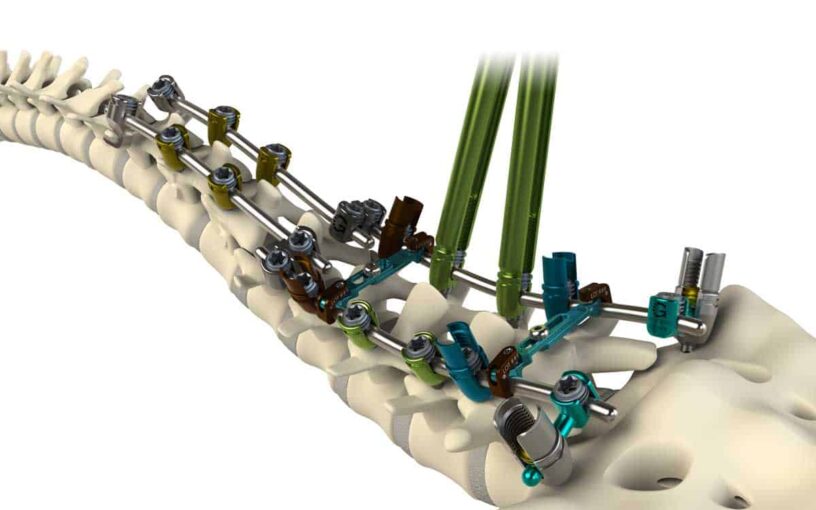The thoracolumbar spine devices market focuses on medical devices used for the treatment and management of thoracolumbar spine disorders. The thoracolumbar spine refers to the area of the spine that includes both the thoracic (mid-back) and lumbar (lower back) regions. Conditions affecting this region can range from degenerative disc disease to fractures and scoliosis. Thoracolumbar spine devices include various implants and instruments designed to support, stabilize, and repair the spine.
Market Size and Growth
The thoracolumbar spine devices market is growing due to an aging population, increasing incidence of spine-related disorders, and advancements in spinal surgery technologies. The market’s expansion is driven by the need for effective treatments to manage spinal conditions and improve patient outcomes.
Key Components of the Thoracolumbar Spine Devices Market
- Types of Devices:
- Spinal Implants: Includes devices such as rods, screws, plates, and cages used to stabilize the spine following surgery. These implants support the spine and promote healing.
- Pedicle Screws: Screws inserted into the vertebral pedicles to provide stability.
- Interbody Cages: Cages inserted between vertebrae to support spinal fusion.
- Spinal Plates: Plates used to hold vertebrae together during the healing process.
- Spinal Fusion Devices: Devices designed to promote fusion of the vertebrae to stabilize the spine. Includes various types of bone grafts and fusion materials.
- Dynamic Stabilization Devices: Devices that provide stability while allowing some movement, aimed at preserving spinal motion.
- Minimally Invasive Spine Devices: Tools and implants used in minimally invasive spine surgery, which reduces recovery time and surgical trauma.
- Correction Devices: Includes devices for scoliosis correction and other deformities.
- Spinal Implants: Includes devices such as rods, screws, plates, and cages used to stabilize the spine following surgery. These implants support the spine and promote healing.
- Applications:
- Degenerative Disc Disease: Treatment of conditions where intervertebral discs deteriorate and cause pain or instability.
- Spinal Fractures: Management of fractures resulting from trauma or osteoporosis.
- Scoliosis: Correction of abnormal curvature of the spine.
- Spinal Stenosis: Treatment of narrowing of the spinal canal that can compress nerves and cause pain.
- Spinal Fusion: Procedure to fuse two or more vertebrae together to stabilize the spine.
- End-User Segments:
- Hospitals: Major settings for spinal surgeries and the use of thoracolumbar spine devices.
- Orthopedic and Neurosurgery Clinics: Specialized clinics focusing on spinal disorders and treatments.
- Rehabilitation Centers: Facilities providing post-surgical care and rehabilitation for spine patients.
- Ambulatory Surgical Centers (ASCs): Offer minimally invasive spine surgeries and treatments.
Market Trends
- Technological Advancements: Development of innovative spine devices with improved materials, designs, and minimally invasive techniques.
- Rising Incidence of Spine Disorders: Increasing prevalence of conditions such as degenerative disc disease and spinal fractures, driving demand for devices.
- Minimally Invasive Surgery: Growing preference for minimally invasive techniques that reduce recovery times and improve patient outcomes.
- Integration with Robotics: Use of robotic systems to assist in spinal surgeries, enhancing precision and outcomes.
- Customization and Personalization: Development of personalized spinal implants based on patient-specific anatomical data.
Market Drivers
- Aging Population: Increasing number of elderly individuals who are more likely to suffer from spinal disorders and require surgical interventions.
- Rising Spine Disorder Prevalence: Growth in the number of patients with spinal conditions due to lifestyle factors, obesity, and other health issues.
- Advances in Technology: Innovations in spinal devices and surgical techniques improving outcomes and driving market growth.
- Healthcare Infrastructure: Expanding access to advanced healthcare facilities and spinal treatments.
- Patient Demand: Growing awareness and demand for effective and minimally invasive spine treatments.
Challenges
- High Costs: The expense associated with advanced spinal devices and surgical procedures can be a barrier to widespread adoption.
- Surgical Risks: Risks and complications associated with spinal surgery, including infection, implant failure, and nerve damage.
- Regulatory Hurdles: Navigating complex regulatory requirements for device approval and market entry.
- Device Reimbursement: Variability in insurance coverage and reimbursement rates for spinal devices and surgeries.
- Competition: Intense competition among manufacturers and the need for continuous innovation to stay ahead in the market.
Click Here, To Get Free Sample Report https://stringentdatalytics.com/sample-request/thoracolumbar-spine-devices-market/14486/
Market Segmentations:
Global Thoracolumbar Spine Devices Market: By Company
Stryker
Zimmer Biomet
Aesculap Implant Systems
Globus Medical
Global Thoracolumbar Spine Devices Market: By Type
Vertebral Body Replacement System
MACS TL/MACS II System
Spinal System
Spondylolisthesis Reduction Instrumentation (SRI)
Fracture Reduction Instrumentation (FRI)
Others
Global Thoracolumbar Spine Devices Market: By Application
Hospitals
Clinics
Others
Global Thoracolumbar Spine Devices Market: Regional Analysis
The regional analysis of the global Thoracolumbar Spine Devices market provides insights into the market’s performance across different regions of the world. The analysis is based on recent and future trends and includes market forecast for the prediction period. The countries covered in the regional analysis of the Thoracolumbar Spine Devices market report are as follows:
North America: The North America region includes the U.S., Canada, and Mexico. The U.S. is the largest market for Cold-chain Pharma in this region, followed by Canada and Mexico. The market growth in this region is primarily driven by the presence of key market players and the increasing demand for the product.
Europe: The Europe region includes Germany, France, U.K., Russia, Italy, Spain, Turkey, Netherlands, Switzerland, Belgium, and Rest of Europe. Germany is the largest market for Cold-chain Pharma in this region, followed by the U.K. and France. The market growth in this region is driven by the increasing demand for the product in the automotive and aerospace sectors.
Asia-Pacific: The Asia-Pacific region includes Singapore, Malaysia, Australia, Thailand, Indonesia, Philippines, China, Japan, India, South Korea, and Rest of Asia-Pacific. China is the largest market for Cold-chain Pharma in this region, followed by Japan and India. The market growth in this region is driven by the increasing adoption of the product in various end-use industries, such as automotive, aerospace, and construction.
Middle East and Africa: The Middle East and Africa region includes Saudi Arabia, U.A.E, South Africa, Egypt, Israel, and Rest of Middle East and Africa. The market growth in this region is driven by the increasing demand for the product in the aerospace and defense sectors.
South America: The South America region includes Argentina, Brazil, and Rest of South America. Brazil is the largest market for Cold-chain Pharma in this region, followed by Argentina. The market growth in this region is primarily driven by the increasing demand for the product in the automotive sector.
Click Here, To Buy Premium Report https://stringentdatalytics.com/purchase/thoracolumbar-spine-devices-market/14486/?license=single
Reasons to Purchase this Market Report:
- The competitive environment includes the proportions of important players, recent innovations, and strategy.
- Companies with extensive product offerings, pertinent financial data, recent advancements, SWOT analyses, and player tactics.
- Quantitative, qualitative, value (in USD million), and volume (in units million) data are among the segments and sub-segments.
- The research contains a wealth of data, including market dynamics and opportunities throughout the forecast period.
- Data at the regional, sub-regional, and national levels also provides information on the market’s supply and demand dynamics.
About Stringent Datalytics
Stringent Datalytics offers both custom and syndicated market research reports. Custom market research reports are tailored to a specific client’s needs and requirements. These reports provide unique insights into a particular industry or market segment and can help businesses make informed decisions about their strategies and operations.
Syndicated market research reports, on the other hand, are pre-existing reports that are available for purchase by multiple clients. These reports are often produced on a regular basis, such as annually or quarterly, and cover a broad range of industries and market segments. Syndicated reports provide clients with insights into industry trends, market sizes, and competitive landscapes. By offering both custom and syndicated reports, Stringent Datalytics can provide clients with a range of market research solutions that can be customized to their specific needs.
Contact Us
Stringent Datalytics
Contact No- +1 346 666 6655
Email Id- sales@stringentdatalytics.com
Web- https://stringentdatalytics.com/




Leave a Reply